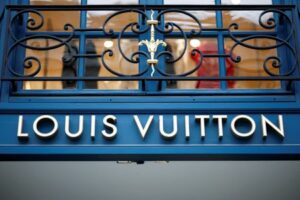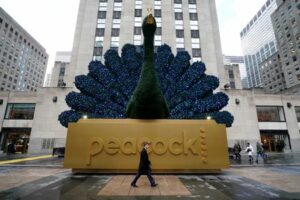By Mimosa Spencer
PARIS (Reuters) -Investors dived back into top luxury shares on Friday, adding some $70 billion to their market value as LVMH’s latest sales figures reassured investors about the sector’s resilience to economic headwinds, particularly in China.
The buying spree helped recoup some of last year’s losses after China’s economic revival proved lacklustre following the lifting of COVID-19 restrictions.
Shares in LVMH jumped as much as 11%, adding about $30 billion to its own stock market value and boosting peers of the French luxury giant including Kering and Hermes.
That helped lift the pan-European STOXX 600 index to its highest level in two years.
LVMH, the world’s biggest luxury group and owner of brands including Louis Vuitton, Christian Dior, Hennessy and Tiffany & Co, posted a 10% rise in fourth-quarter sales over the end-of-year trading period, reassuring investors who had grown skittish about the industry’s prospects following its previous update in October which showed sales growth had slowed.
LVMH Chairman and CEO Bernard Arnault said on Thursday he was happy with the company’s current growth rate.
With its latest report, LVMH should “steady nerves in the near term”, Jefferies analyst James Grzinic wrote in a note.
For many investors, LVMH’s resilience was reason enough to buy back into the sector again.
With LVMH set for its best day since 2009, shares breached technical resistance levels and investors with bearish bets rushed to cover short positions.
LVMH’s relative strength index (RSI) hit 72 on Friday afternoon, its most overbought level for a year.
CHINESE DEMAND
Appetite from Chinese shoppers for European fashion brands has been a key source of concern for investors in recent months, as a property crisis and high youth unemployment dashed hopes for a strong rebound, and Chinese travel beyond Asia has been slow to recover.
Executives at LVMH said it was hard to measure Chinese demand, but noted that the group has twice as many Chinese customers as it did in 2019.
“We’re not particularly concerned,” said LVMH chief financial officer Jean-Jacques Guiony.
While large bus loads of Chinese customers are no longer arriving in Europe, the group is doing brisk business with wealthier Chinese customers. LVMH’s biggest label Louis Vuitton is back to sales levels with Chinese in France and Europe of 70% of 2019 levels.
The luxury goods industry had come to rely on fast growth in China, where over the span of five years, from 2017 to 2021, the luxury market tripled in size, according to consultancy Bain.
Chinese luxury consumption is expected to reach 35-40% of the world’s total, with mainland China one of the leading global markets reaching a 24%-26% share by 2030, according to Bain.
As the sector’s growth slows from the high pace seen after the pandemic, the diverging fortunes of brands has come into view, with those catering to wealthier clients, like Hermes, better equipped to face economic challenges than those pursuing turnarounds, like Burberry, which issued a profit warning earlier this month.
Thomas McGarrity, head of equities for RBC Wealth Management, said he expects strong high-end players will be able to defend their margins this year even as sales growth slows, while weaker brands will struggle.
“We believe the medium to long-term structural outlook remains positive for luxury goods, given tailwinds related to emerging middle-class consumption, especially in China, as well as the industry’s strong pricing power,” he said.
Still, shares of Burberry also traded higher on Friday, up 5.2%.
LVMH was the top gainer on the euro-zone blue-chip STOXX50E index.
Friday’s gains added about $70 billion to the value of the top luxury and drinks companies, including LVMH, Gucci-owner Kering, Hermes, Pernod, Remy, Cartier-owner Richemont and Moncler, according to Reuters calculations.
Kering shares traded up 7.2%, Hermes up 5.5%, Richemont up 5.9% and Pernod up 8.1%.
(Reporting by Tassilo Hummel and Mimosa Spencer in Paris, Josephine Mason in London; Additional reporting by Lucy Raitano in London; Editing by Mark Potter, Elaine Hardcastle)





